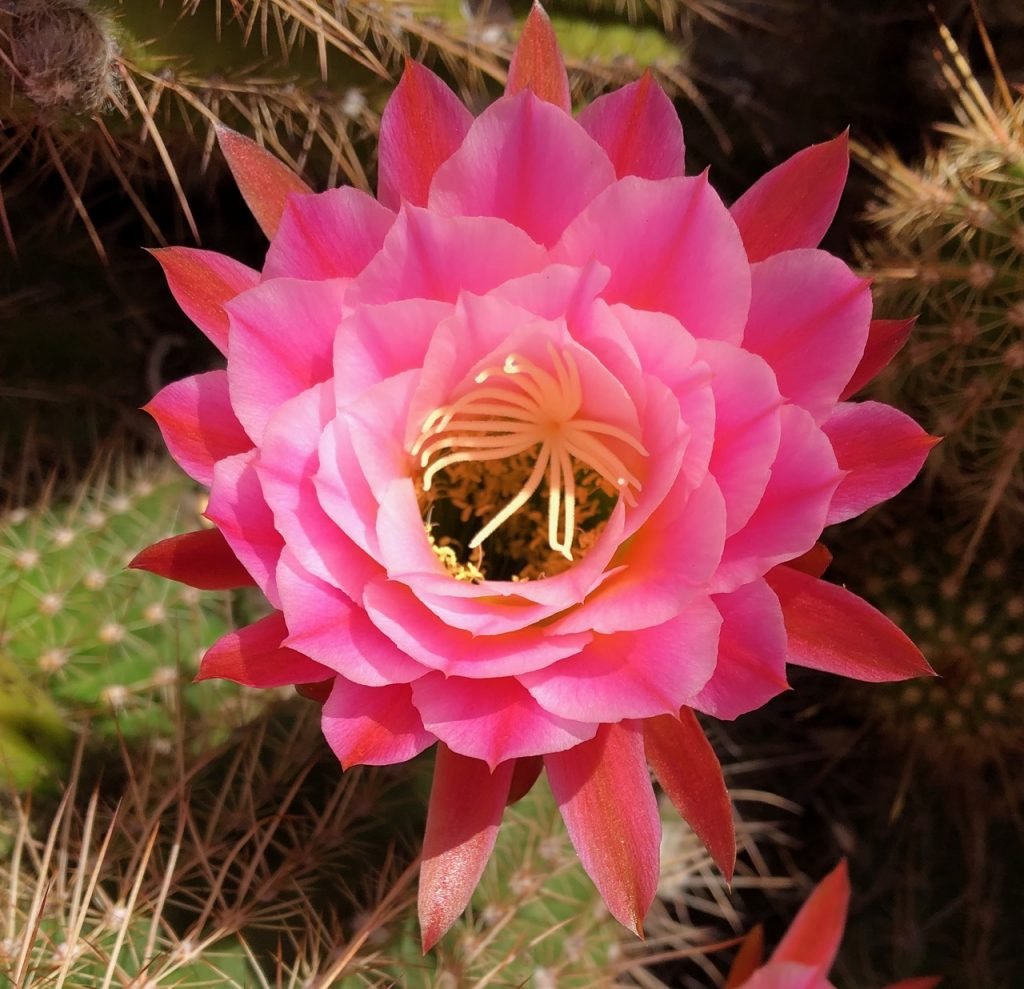A cactus with pink flowers is more than just a desert gem—it’s a burst of color and character in your living space. For indoor plant lovers, these blooming beauties are becoming a favorite in home décor thanks to their low-maintenance needs, striking shapes, and vibrant hues.
Whether you live in a sunny apartment, a cozy home office, or a light-filled loft, adding a pink flowering cactus can bring a cheerful, unexpected touch to your indoor oasis.
But what makes these cacti so special? It’s not just their bold looks. These indoor cactus plants with pink flowers combine durability with delicate beauty, offering the best of both worlds.
In this guide, we’ll walk you through everything you need to know—from the best pink-flowered cacti to growing conditions, care tips, and design ideas.
Whether you’re a total beginner or just searching for your next plant crush, this article will help you choose and care for the perfect blooming cactus for your home.
Why Choose an Indoor Cactus with Pink Flowers
When it comes to brightening up indoor spaces, few plants make a statement like a cactus with pink flowers. These stunning plants are not just beautiful—they’re practical, too.
For plant lovers in small apartments, city dwellings, or low-maintenance households, these cacti offer a stylish and stress-free way to bring nature indoors.
1. Long-lasting blooms with minimal effort
Unlike many other flowering houseplants that demand constant humidity, pruning, or feeding, pink flowering cacti thrive on neglect.
Their blooms are not only vivid but often long-lasting, especially if you provide them with bright, indirect light and proper care. You get a splash of color without the daily work.
2. Adapted for modern living
In 2025, more people than ever are growing plants in small spaces. Whether you’re in a sunny kitchen corner or a glassy high-rise, indoor cacti with pink blossoms fit seamlessly into your lifestyle.
Their compact growth, low watering needs, and slow-growing nature make them ideal for urban settings.
3. A pop of personality in any room
Pink flowers evoke warmth, love, and cheer—making them perfect for home offices, bedrooms, or entryways.
These blooms bring a soft contrast to the bold, often spiky textures of cacti. Planted in a chic ceramic pot or hanging basket, they double as living art.
4. Symbolism and meaning
Cacti are known for their resilience, and when they bloom—especially in such rare hues like pink—it’s a symbol of unexpected joy, endurance, and quiet beauty. They’re more than just plants; they’re a statement.
Whether you’re after a botanical conversation piece or a gentle mood boost, pink flowering cactus plants bring life and color to your home without the high-maintenance drama.
Top Indoor Cactus Varieties That Bloom Pink
Looking to add a splash of pink to your indoor garden? These are the top indoor cactus varieties known for their beautiful pink blossoms.
Each one brings a distinct shape, color, and charm—making them ideal for decorating tabletops, shelves, or sunny window sills.
Gymnocalycium mihanovichii (Moon Cactus)

A fan favorite for a reason, the moon cactus is small but visually striking. Its neon-colored top—often pink, red, or orange—is actually a grafted flowering cactus that thrives indoors with bright, indirect light. It’s an excellent choice for beginners because of its manageable size and minimal care needs.
Why it’s great: That bold pop of pink isn’t just a flower—it’s the cactus itself, making this a year-round showstopper.
Schlumbergera (Christmas Cactus)
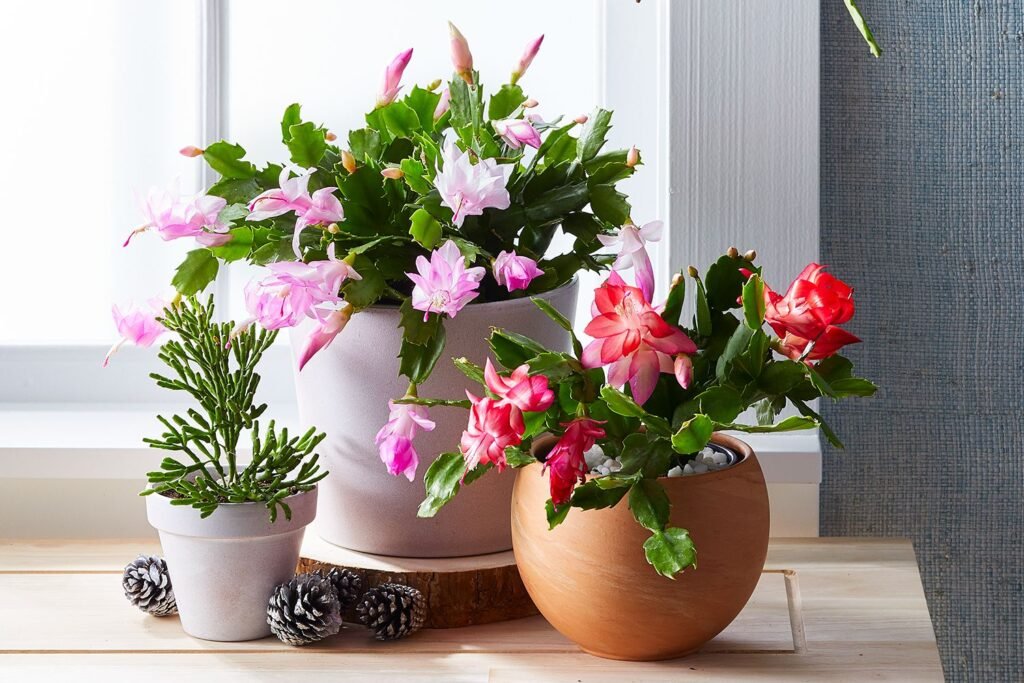
Technically a succulent cactus, the Christmas cactus blooms beautifully with fuchsia or bright pink flowers during winter holidays. Unlike most desert cacti, it prefers a bit more humidity and thrives in indirect light, making it perfect for indoor environments.
Why it’s great: One of the few indoor cactus plants that reliably blooms every year.
Echinopsis oxygona (Easter Lily Cactus)
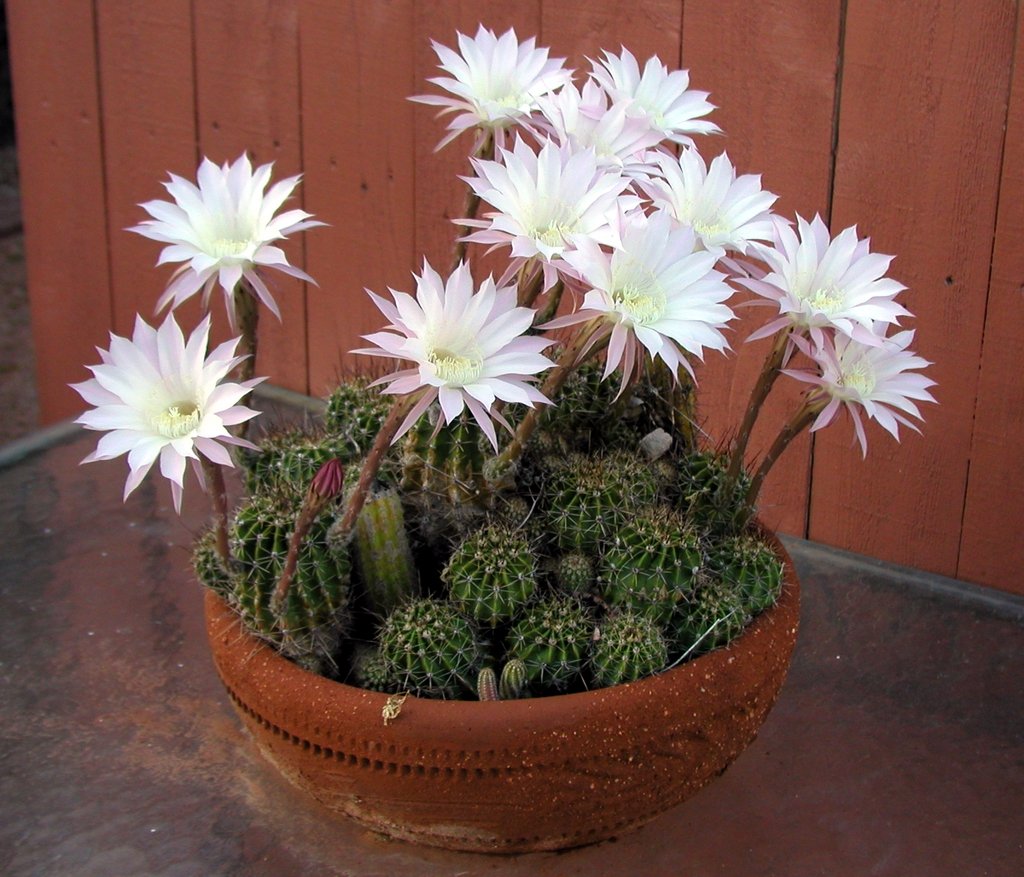
This spherical cactus surprises with large, stunning blooms in pink or purple hues. The flowers often open at night and last for a day or two, giving a dramatic display when they do appear. They enjoy sunny windows and require little water.
Why it’s great: Perfect for plant lovers who appreciate surprise blooms and sculptural shapes.
Mammillaria species

Many Mammillaria varieties, like Mammillaria zeilmanniana, produce adorable crown-like rings of pink flowers. They stay compact and are easy to grow indoors with bright sunlight and minimal watering.
Why it’s great: The floral rings create a soft, feminine look on a rugged little plant.
Rebutia
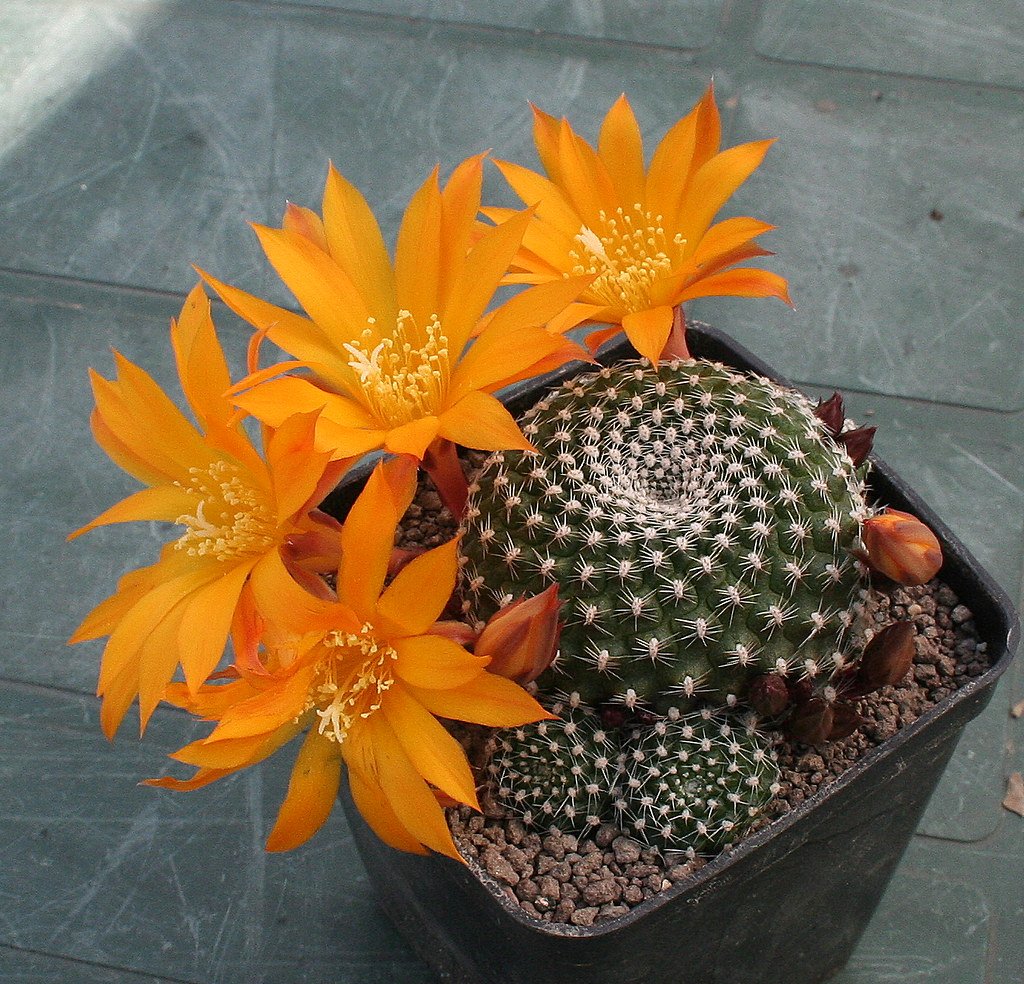
These mini globular cacti are some of the best bloomers among cactus types. They often produce vivid pink or red flowers that cover the entire plant in a vibrant display. They’re especially suited to windowsills and shallow pots.
Why it’s great: Small size and big flower power.
Echinocereus pectinatus
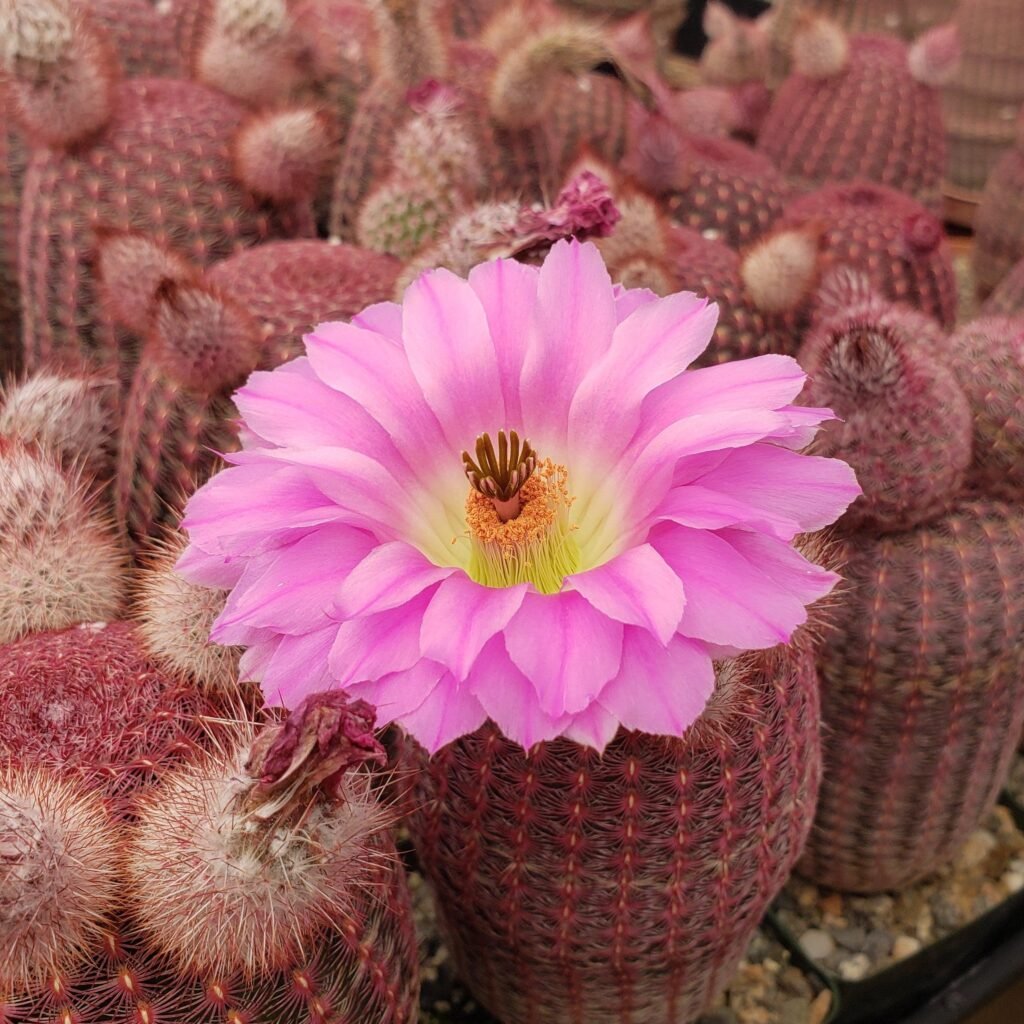
This species produces large, satin-pink flowers with bright yellow centers. It prefers a lot of sun and well-draining soil but is otherwise very forgiving indoors.
Why it’s great: Showy, dramatic flowers on a manageable indoor cactus.
Parodia haselbergii
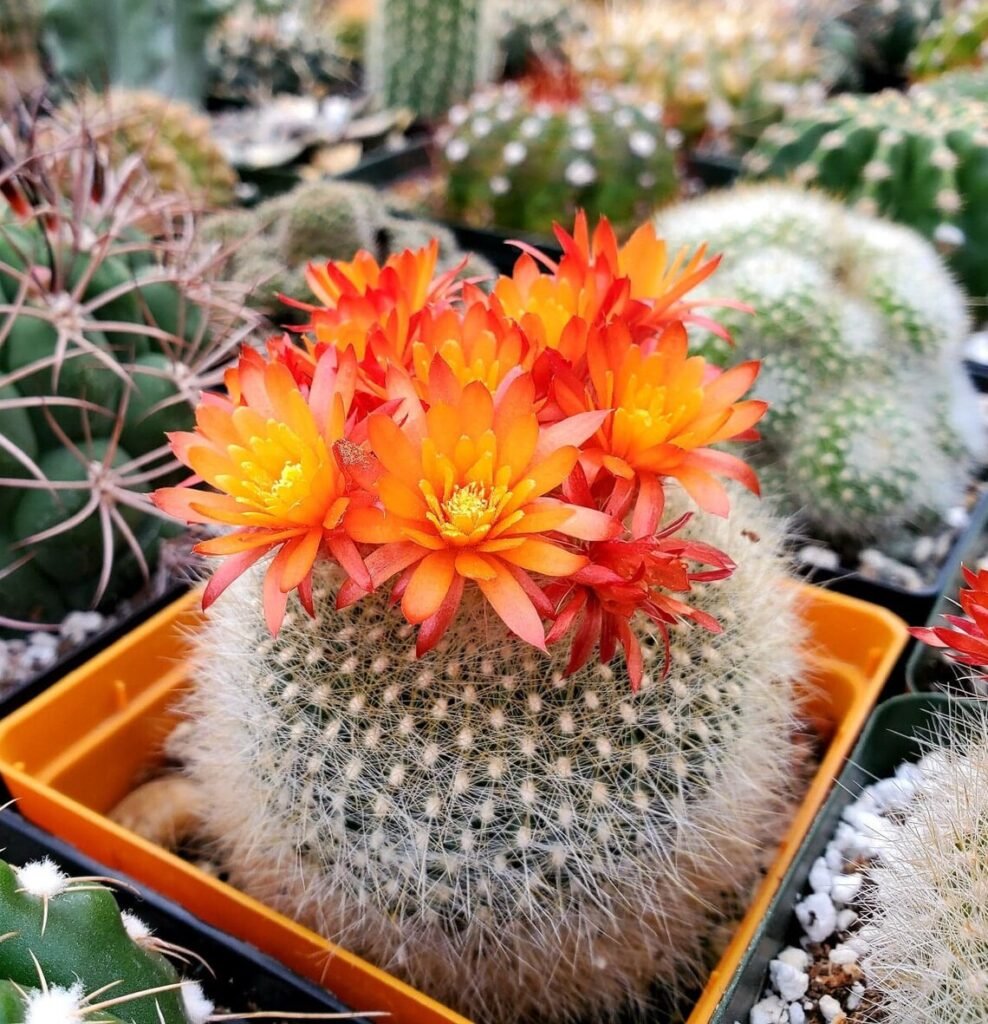
This cactus forms soft, spiny mounds that bloom with pink to magenta flowers throughout the warmer months. It tolerates partial sun and moderate indoor conditions well.
Why it’s great: A good fit for less sunny rooms that still get a few hours of daylight.
Opuntia microdasys (Bunny Ear Cactus)
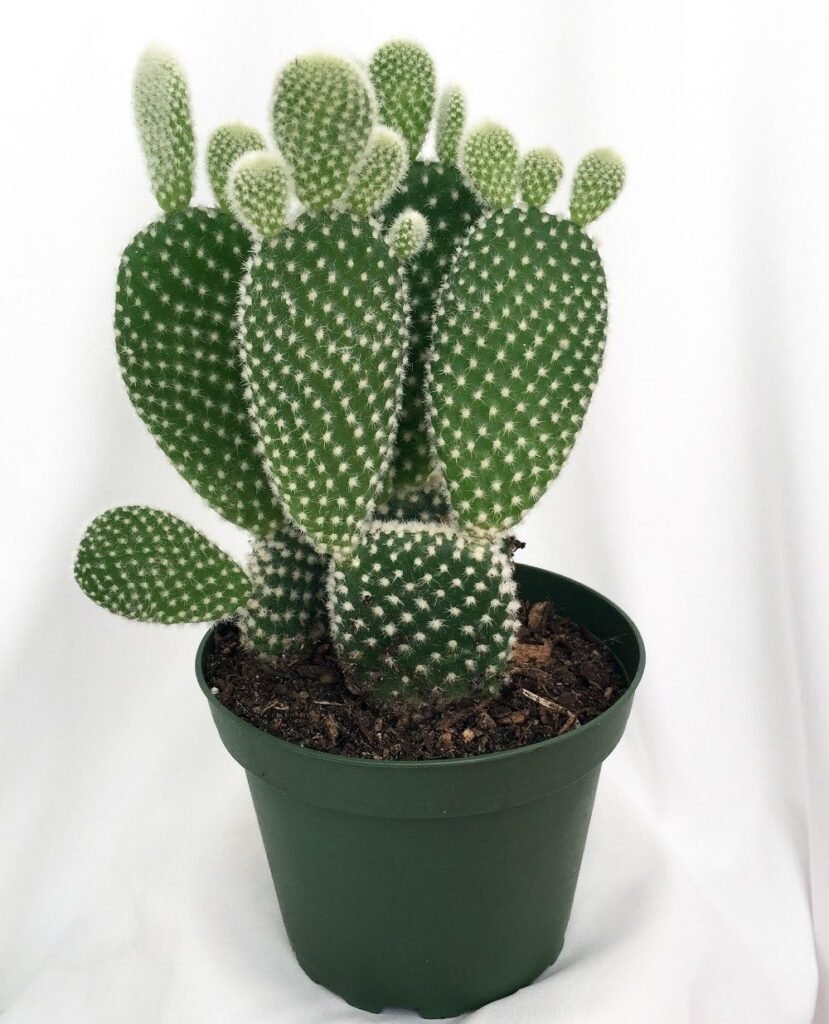
While its blooms are rarer indoors, certain hybrids can produce pink-tinted flowers under strong light. Known for its cute, pad-shaped growth, it’s a great visual piece even without blooms.
Why it’s great: Unique shape and a good candidate if you have a sunny spot.
Ideal Growing Conditions for Pink Flowering Cacti
While cacti are generally tough, indoor conditions can differ a lot from their natural desert environment. To encourage blooming—especially those pretty pink cactus flowers—you’ll need to mimic certain conditions carefully. Here’s what your cactus needs to truly thrive indoors.
Lighting: Bright but Not Harsh
Cacti that bloom indoors—especially those producing pink flowers—need bright light. A south or west-facing window is usually ideal, giving your cactus the hours of daylight it craves without scorching its tissues. If natural light is limited, consider a full-spectrum grow light to supplement.
Rotate the plant every couple of weeks so all sides get equal light exposure. Uneven light can cause leaning or weak growth.
Soil: Drainage is Everything
These plants hate sitting in wet soil, which can rot their roots and prevent blooming. Use a cactus-specific potting mix or make your own by combining:
- 2 parts potting soil
- 1 part perlite
- 1 part coarse sand
The result should be a light, fast-draining mix that mimics desert soil.
Temperature: Warm and Stable
Most indoor cacti prefer temperatures between 18–26°C (65–79°F). A small drop at night can encourage flowering in some species, like the Christmas cactus, but try to avoid placing your plant near cold drafts or heat vents.
During winter, they can tolerate cooler nights—down to around 10°C (50°F)—which mimics their natural dormancy cycle.
Humidity: Keep It Dry
Unlike tropical plants, flowering cacti do best in dry air. That makes them ideal for apartments and modern homes where indoor humidity is typically low. Avoid misting and don’t crowd them with moisture-loving plants.
Pot Choice: Size and Drainage
A small pot with drainage holes is essential. Terracotta pots are especially useful because they absorb excess moisture and allow air to reach the roots.
Choosing the right conditions is the first step to encouraging vibrant pink cactus blooms year after year.
Caring Tips to Encourage Pink Blooms
Getting a cactus to bloom indoors, especially one with pink flowers, requires a little more than sunlight and water. Many cactus owners wonder why their plant looks healthy but never flowers. The secret lies in a few specific care tips tailored to the flowering cycle of indoor cacti.
Provide a Proper Dormancy Period
Most cacti need a resting period—usually during winter—to reset and build energy for blooming. During this time, reduce watering drastically and avoid feeding. Place the cactus in a cooler area (about 10°C to 13°C or 50°F to 55°F) with indirect light. Once spring hits, gradually reintroduce water and warmth to stimulate flower development.
Avoid Overwatering
Excess water is the enemy of both cactus health and blooming. Water only when the soil is completely dry—this could mean every 2 to 4 weeks, depending on the season and indoor conditions. Always let water drain fully and never let the pot sit in standing water.
Feed During Growing Season
Cacti need nutrients to produce flowers. Use a balanced cactus fertilizer or a bloom booster with low nitrogen and higher phosphorus content. Feed once a month during spring and summer, then stop during fall and winter. Over-fertilizing can lead to leggy growth instead of flowers.
Limit Repotting
Avoid repotting your cactus every year unless it’s root-bound. Many cacti bloom better when slightly snug in their pots. Repot only when necessary, ideally after blooming season.
Provide Consistent Light
Light consistency is important. Even moving a cactus to a new window can disrupt blooming. Try to keep your plant in one well-lit spot, and rotate the pot every few weeks to promote even growth.
Don’t Panic if It Takes Time
Some flowering cacti, especially Echinopsis or Mammillaria, may not bloom until they’re mature—which could take a few years. Be patient. A healthy cactus will reward your care with a stunning pink display when the time is right.
Decorating Ideas with Pink Cactus Blooms
Cacti with pink flowers aren’t just plant companions—they’re instant mood lifters and decor accents. Their vivid blooms and sculptural shapes make them ideal for brightening up indoor spaces in creative, stylish ways. Whether your home leans modern, boho, or minimalist, these flowering plants fit right in.
Brighten Up a Windowsill or Shelf
One of the simplest ways to show off your indoor cactus with pink flowers is by placing it on a sunny windowsill. Choose a trio of small flowering varieties like Mammillaria, Rebutia, and Gymnocalycium in matching or complementary pots. The varying shapes and blooms create a layered, cheerful display.
Use as a Table Centerpiece
A blooming cactus in a beautiful ceramic pot makes an elegant and unexpected centerpiece. Pair it with natural materials like wood, stone, or linen to create a warm contrast. Try grouping with other succulents or air plants for added interest.
Create a Blooming Wall Niche
If you have a wall niche or corner shelf, spotlight your cactus with proper lighting and a decorative pot. Pink-flowered cacti pop especially well against white, black, or gray backdrops.
Add to Your Home Office or Reading Nook
Boost productivity and mood with a small blooming cactus on your desk or side table. The soft pink hues add calm without distraction.
Cactus flowers aren’t just pretty—they’re design statements. Their unusual beauty blends nature and art, making them a favorite among plant lovers and home stylists alike.
Common Problems with Indoor Flowering Cacti
Even the hardiest indoor cacti can run into trouble. Whether you’re a new plant parent or an experienced grower, being able to spot and solve issues quickly is key to maintaining healthy, blooming cacti—especially those prized for their pink flowers.
Problem: No Flowers Even After a Year
Solution: Cactus blooms depend on maturity, proper dormancy, and environmental cues. If your cactus is healthy but not flowering, it may be too young or not receiving enough light. Consider if you’ve allowed a cool, dry dormancy period and if it’s getting 6+ hours of light daily.
Problem: Mushy or Rotting Stems
Solution: Overwatering is the usual culprit. Cut away soft, dark spots with a sterile knife and let the cactus dry out completely. Repot in dry, fast-draining soil. Reduce watering schedule and make sure the pot has proper drainage.
Problem: Pale or Stretched Growth (Etiolation)
Solution: This happens when a cactus isn’t getting enough light. Move it to a sunnier location or supplement with a full-spectrum grow light. Rotate the pot regularly to prevent one-sided growth.
Problem: Buds Form but Never Bloom
Solution: This can be due to environmental stress like sudden movement, overwatering, or fluctuating light. Once buds appear, keep the cactus in a stable location and avoid drafts or repotting.
Problem: Pests (Mealybugs, Spider Mites)
Solution: Use a cotton swab dipped in rubbing alcohol to remove visible pests. For infestations, spray with neem oil or an insecticidal soap. Always isolate new plants to avoid spreading pests.
Addressing these common issues proactively will not only keep your cactus healthy but also increase your chances of enjoying those gorgeous pink blooms more often.
Is It Pet Safe? Understanding Cactus Toxicity
One of the most common concerns among indoor plant lovers is whether their flowering cactus is safe around pets. If you have curious cats or playful pups, it’s smart to consider toxicity and physical safety.
Are Cacti Toxic to Pets?
The good news is that most indoor cacti, including those with pink blooms like Mammillaria, Echinopsis, and Rebutia, are non-toxic to cats and dogs, according to the ASPCA. That said, it’s still best to keep them out of reach—not because of poison, but because of spines.
If a pet brushes against or chews on a cactus, they could end up with painful scratches or embedded spines. That’s unpleasant for them and you.
Safer Alternatives or Precautions
- Place your cactus on high shelves or hanging planters.
- Choose spineless varieties like the Christmas cactus, which is both pet-safe and soft to touch.
- Train pets early to avoid plant areas or use gentle deterrents like citrus sprays.
If your pet does have a run-in with a spiky plant, monitor for any swelling or discomfort and consult a vet if needed.
So while many indoor pink-flowering cacti are safe to have in homes with pets, a little caution helps everyone coexist peacefully.
FAQ: Indoor Cactus with Pink Flowers
How long do cactus flowers last indoors?
The blooming period varies by species. Some, like Echinopsis, bloom for just a day, while others like the Christmas cactus can flower for weeks. Keeping conditions stable (light, water, temperature) helps flowers last longer.
Do all cacti flower eventually?
Most cacti can bloom, but not all will do so indoors—especially without enough light or proper dormancy. Some species may take several years before flowering for the first time.
What’s the easiest cactus with pink flowers for beginners?
The Christmas cactus is one of the easiest to care for and rewards you with bright blooms during the winter. It’s forgiving, doesn’t have harsh spines, and thrives in typical indoor conditions.
Can I force a cactus to bloom indoors?
Not exactly. You can encourage blooming by providing the right environment—plenty of light, proper soil, dormancy in winter, and correct watering—but flowering ultimately depends on the plant’s age and health.
Why are my cactus buds dropping off?
This often happens due to sudden changes in temperature, light, or watering during bud development. Try to keep conditions stable once buds appear.
Final Thoughts
Indoor cactus with pink flowers is more than just a botanical trend—it’s a beautiful blend of resilience and charm that adds warmth and color to any living space.
Whether you’re nurturing a delicate Mammillaria, admiring the overnight bloom of an Echinopsis, or styling a fuss-free Christmas cactus on your shelf, each pink bloom is a reward for your patience and care.
These flowering cacti don’t ask for much—just good light, thoughtful watering, the right potting mix, and a little seasonal rest.
Give them that, and they’ll brighten your home with vibrant hues and sculptural elegance.
As you decorate your apartment or workspace, don’t overlook the power of these small but striking plants.
They fit into minimalist designs, boho shelves, office desks, or even as thoughtful gifts for plant-loving friends. And with most of them being non-toxic to pets and low-maintenance, they’re an easy win for plant enthusiasts at any level.
Ready to welcome a touch of pink into your indoor garden? Start small, stay consistent, and enjoy the journey—because growing a cactus that flowers indoors isn’t just about the blooms, but the quiet joy of watching something thrive under your care.
